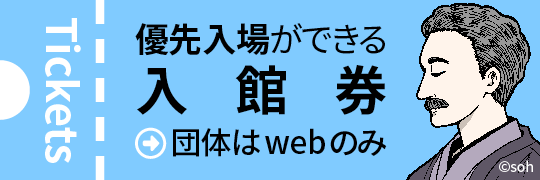企画展
八雲が愛した日本の美
彫刻家 荒川亀斎と小泉八雲
Exhibition
The Japanese Aesthetic Hearn Loved
Sculptor Arakawa Kisai & Lafcadio Hearn
2018年6月27日(水)―2019年6月9日(日)
1階 展示室3
荒川亀斎(初代)は1827年4月25日、松江の雑賀横浜にて木工職人荒川茂蔵の子として誕生しました。名は明生、通称名は重之輔。亀斎は幼少の頃より彫刻界の天童と謳われ、地元では名の通った彫刻家でした。
1890年8月に松江に赴任した小泉八雲は、散歩中に出会ったあるお寺の石地蔵に魅了されます。それは寺町の龍昌寺にある慈愛に満ちた地蔵で、八雲はすぐにその作者を尋ね、「荒川亀斎」という名を知りました。翌日、さっそく亀斎の工房を訪ねた折、その腕前と名人気質に惚れ込み、二人は美術論をかわし意気投合したといいます(山陰新聞)。その後も、八雲は亀斎に作品を注文し、この彫刻家を世に紹介しようと、いわゆる作家のプロデュースを買って出ます。二人の関係は、八雲の著作や親友で島根県尋常中学校の教頭西田千太郎の日記と西田宛書簡、当時の山陰新聞などで、その交流を垣間見ることができます。
中でも、亀斎が八雲に見せた「気楽坊人形」は、作品「英語教師の日記から」(『知られぬ日本の面影』所収)に詳しく紹介されています。これを見て大変よろこんだ八雲のもとに、亀斎は「気楽坊」を模した人形を作成し贈呈しました(小泉八雲記念館蔵)。また、八雲は、1893年のシカゴ万博への出品を勧め、アドバイスもしています。この万博で「稲田姫像」(出雲大社蔵)が優等賞を獲得し、亀斎は彫刻家として不動の地位を築きました。
この企画展では、八雲が見出した郷土の作家・荒川亀斎の作品およびその周辺を紹介するとともに、著作や西田日記などの中に登場する亀斎とのエピソードをたどることで、小泉八雲の審美眼・美術観を探り八雲の新たな側面を紹介していきます。また、小泉八雲記念館が所蔵する荒川亀斎の作品をはじめ、最近発見された亀斎が八雲に見せた「気楽坊人形」(人形劇の図書館蔵)を初公開するとともに、主に出雲地方に点在する作品(「ヒポクラテス像扁額」〔株式会社城見エステート蔵〕、「八雲が注文して作らせた仏像(未完)」〔石谷家蔵〕など)の作品展示や映像・写真による展示を行います。八雲の著書や西田千太郎への書簡、当時の山陰新聞などから荒川亀斎という異才に迫っていきたいと思います。
参考
- 『荒川亀斎傳』
- 『天才彫刻家 荒川亀斎翁伝』松江先人記念館
- 『西田千太郎日記』島根郷土資料刊行会
- 『教育者ラフカディオ・ハーンの世界』ワン・ライン
- 『写真でたどるハーンの1年2ヵ月』株式会社江友
- 山陰新聞
- 『小泉八雲事典』恒文社
主催:小泉八雲記念館
共催:松江市、山陰中央新報社
協力:荒川家、石谷家、出雲大社、島根大学附属図書館、島根県立図書館、株式会社城見エステート、長岡家、人形劇の図書館、松江先人記念館、公益財団法人陽明文庫
後援:八雲会
Wednesday, 27 June 2018–Sunday, 9 June 2019
Exhibition Room 3
The sculptor known as Arakawa Kisai (the First) was born the son of carpenter Arakawa Shigezo on the 25th of April 1827, in the Saikamachi-Yokobama area of Matsue. Kisai’s given name was Akio, but he went by the name Junosuke. From a young age, the sculpting world praised Kisai as a child prodigy. Everyone in town knew the name of this famous sculptor.
In August of 1890, Lafcadio Hearn would be transferred to Matsue, and discover a certain stone statue while out for a walk. Hearn became mesmerized by the statue, a friendly Buddhist Jizo which overflowed with benevolence and belonged to the Ryusho-ji Temple in Teramachi. Hearn immediately asked after the sculptor, and this was how he came to know the name Arakawa Kisai. The very next day, Hearn visited Kisai’s workshop, where he became enamored with the skill and demeanor of the master sculptor. The two men discussed the arts and are said to have hit it off very well (San-in Shimbun Newspaper). Hearn would go on to commission pieces from Kisai in an effort to introduce the sculptor to the world, as a producer might promote an artist. The bond these two men shared can be glimpsed today in Hearn’s writings; the diaries of Nishida Sentaro, who was Deputy Head Teacher of Shimane Prefectural Common Middle School and Hearn’s good friend; letters to Nishida; contemporary newspaper articles (San-in Shimbun); and other sources.
One piece in particular, Kirakubo Ningyo (a jolly old boy), is described in detail in Hearn’s ‘From the Diary of an English Teacher’ (Glimpses of Unfamiliar Japan). Kisai showed this piece to Hearn, who was rather pleased. The sculptor would later create a doll based on the happy-go-lucky Kirakubo, and present Hearn with the creation (Lafcadio Hearn Memorial Museum collections). Hearn later advised Kisai and encouraged the artisan to exhibit his works at the World’s Columbian Exposition of 1893. It was there that Kisai would receive honors for his Statue of Inata-Hime (Izumo Taisha Grand Shrine collections), cementing his place in sculpting history.
This exhibition seeks to introduce the works and story of Arakawa Kisai, the local artisan who Hearn discovered, while tracing Kisai’s appearances in the Nishida diaries and other writings. And, this exhibition explores Hearn’s eye for beauty and aesthetic sense, introducing an altogether new side of Lafcadio Hearn. Featured are the works of Arakawa Kisai from the collections of the Lafcadio Hearn Memorial Museum, as well as the recently-discovered Kirakubo Ningyo, the original doll which Kisai showed Hearn. This rare piece, on loan from the Torokko Puppetry Library, will be shown to the public for the first time. Other works, found mainly throughout the Izumo region, will also be exhibited; such as the Hippocrates Statue Plaque (The Shiromi Estate Co., Ltd. collections), and Buddha Statue Ordered by Hearn, uncompleted (The Ishitani Family collection), which was created to fulfill an order from Hearn. Photographs will be displayed as well. This exhibition seeks to uncover the great genius that was Arakawa Kisai, by piecing together Hearn’s writings, letters to Nishida Sentaro, articles from contemporary newspapers, and other artifacts.
organizer: Lafcadio Hearn Memorial Museum
co-organizers: Matsue City / The San-in Chuo Shimpo Newspaper Co., Ltd.
cooperation: The Arakawa Family / The Ishitani Family / Izumo Taisha Grand Shrine / Shimane University Library / The Shimane Prefectural Library / The Shiromi Estate Co., Ltd. / The Nagaoka Family / Torokko Puppetry Library / Matsue Senjin Museum / Yomei Bunko
sponsor: The Hearn Society
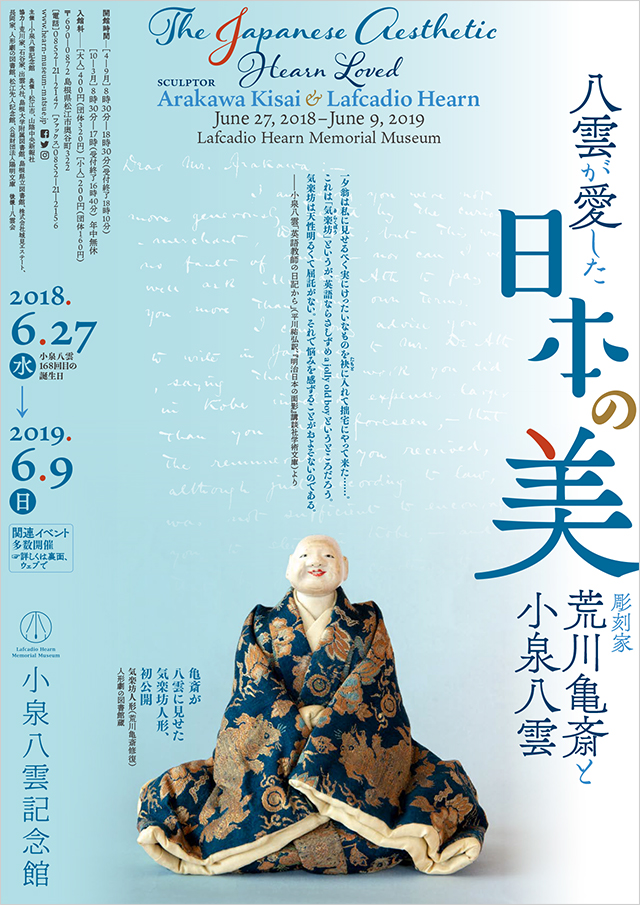
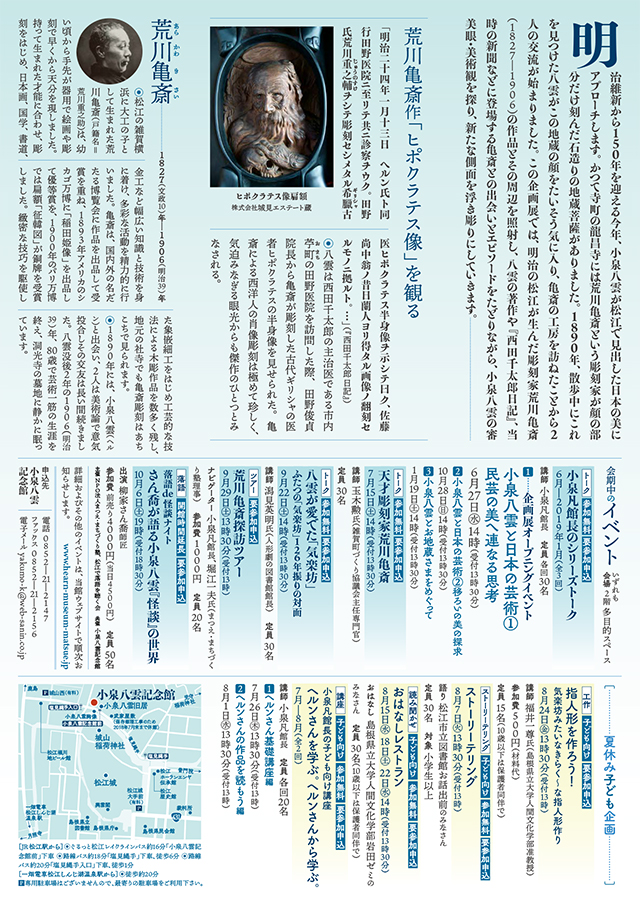
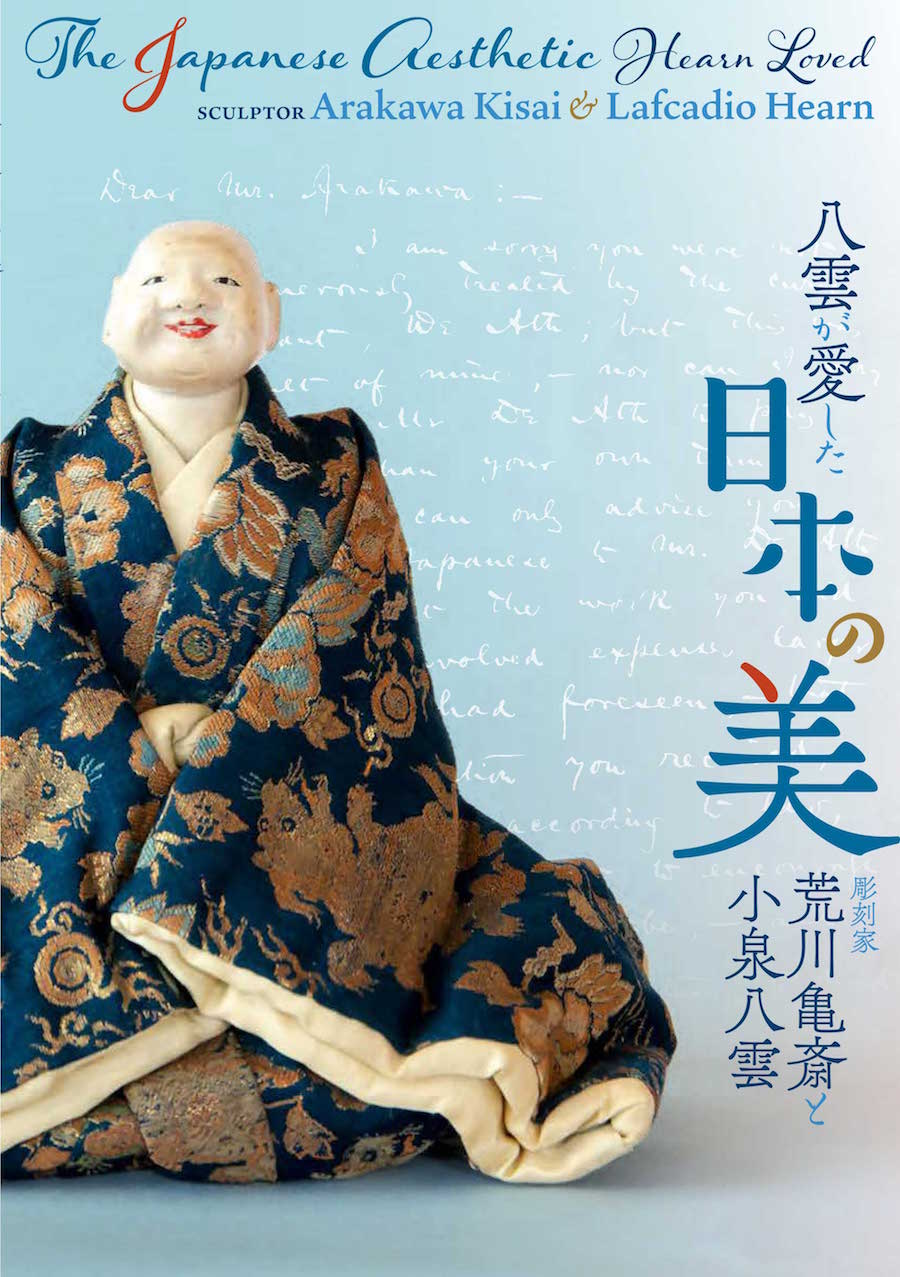
The Exhibition Catalog
本体1,3000円+税
¥1,300 (excluding tax)
1階ミュージアムショップにて販売しています。
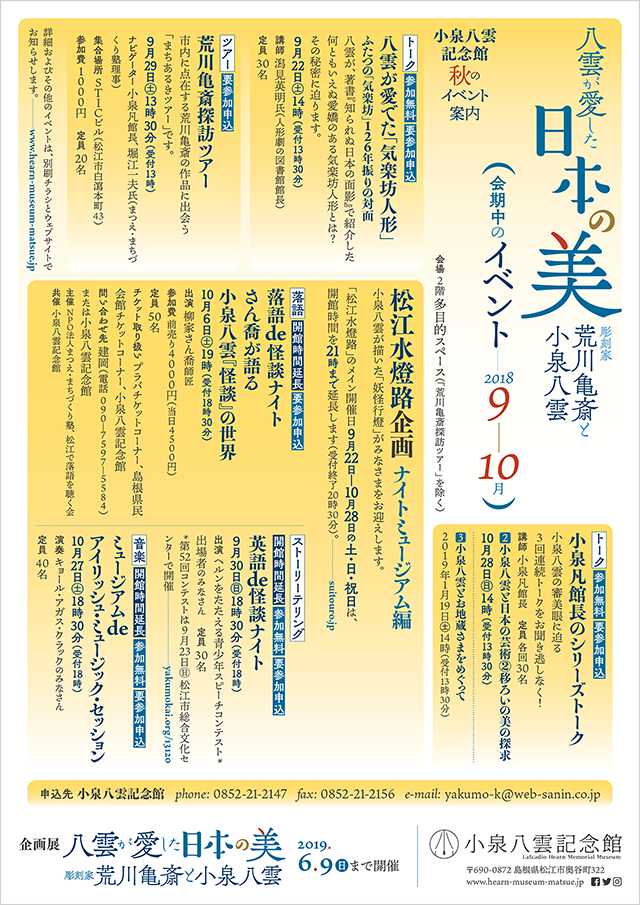
詳しくは会期中のイベントをご覧ください。
荒川亀斎(1827-1906)
荒川亀斎(戸籍名=荒川重之助)は、1827(文政10)年、松江の雑賀横浜に、大工・茂蔵の子として生まれた。3歳の時セミやトンボなどを描き、7歳にして泥天神の絵付けを行い、9歳で巧みに鳥獣人物を彫刻するなど、天分に恵まれた。その後、天才的な工匠として知られる小林如泥の流れをくむ福島卯八に彫刻、高見旦斎に国学と書道、狩野派の飯島雲岳と華岳に絵画、仏師加藤左織に仏像をそれぞれ学び、もって生まれた才能と熱心な修行によって、彫刻家として次第に頭角をあらわした。常教寺の「鐘楼堂の龍」の彫刻は、15歳の時の作である。
その後も金工を学ぶとともに、俳人山内曲川、漢学者内村鱸香などと交わって学問を積み、建築、造園、日本画、洋画と多彩な創作活動を精力的に続けた。さらに、50歳を過ぎてもなお向上心は尽きず、東京、奈良、京都を数回にわたり巡遊して古美術について研究した。
1877(明治10)年に始まった第一回内国勧業博覧会をはじめとする内外の名だたる博覧会に出品して受賞を重ね、その作品は宮内省から買い上げられるほどになった。また、緻密な技巧を駆使し、象嵌細工をはじめ工芸的な技法による木彫作品を数多く残した。亀斎はいわゆる芸術肌の職人気質で、自分の意に沿う仕事をとことん追求すると同時に、彫刻、絵画はもとより、梵鐘デザイン、芝居の舞台美術に至るまでやってのけるマルチタイプの芸術家だった。
1890(明治23)年には、ラフカディオ・ハーン(ヘルン)と出会い、美術論で意気投合する。1893(明治26)年に米国シカゴ万国博覧会に一代の傑作と言われる「稲田姫像」(現・出雲大社蔵)を出品して優等賞を獲得し、彫刻家としての地位を不動のものとした。さらに1900(明治33)年にはパリ世界博覧会で銅牌を得た。
そして八雲没後2年の1906(明治39)年、80歳で芸術一筋の生涯を終え、洞光寺の墓地に眠る。
Arakawa Kisai (1827-1906)
Arakawa Kisai (registered name Junosuke) was born the son of carpenter Shigezo in 1827, in the Saikamachi-Yokobama area of Matsue. He was naturally gifted, drawing cicadas and dragonflies at age three; painting Tenjin dolls at age seven; and adeptly carving birds, animals, and people at age nine. And later, he studied: carving with Fukushima Uhachi, who followed genius craftsman Kobayashi Jodei; classical Japanese literature and calligraphy with Takami Tansai; drawing with Iijima Ungaku and Kagaku, from the Kano school of painting; and Buddhist statues with sculptor Kato Saori. With intensive training, and natural-born talent, Kisai emerged as a sculptor. He carved the Shorodo no Ryu in Jokyo-ji Temple when only fifteen years old.
And even later, Kisai studied metalwork, met with haiku poet Yamanouchi Kyokusen, classical Sinologist Uchimura Roko, and others, acquiring knowledge on various subjects, and continued to create a wide variety of works in architecture, landscaping, and Japanese and Western painting. Kisai’s desire to improve never faded. Even after the age of fifty, he visited Tokyo, Nara, and Kyoto numerous times and researched antique art.
Starting with the first National Industrial Exhibition, which began in 1877, Kisai entered various exhibitions both home and abroad, earning various awards. The Ministry of the Imperial Household of Japan even purchased his works. With skill and detail, Kisai left behind numerous artistic wooden carvings featuring decorative metal inlay and other art techniques. Kisai was a natural-born artist and a true craftsman. A multi-genre artist, he sought out work which suited him, all while effortlessly engaging in Buddhist temple bell design, and even theatrical scenery, in addition to his sculpting and drawing.
Kisai meets Lafcadio Hearn in 1890, and they get along very well while discussing the arts. At the World’s Columbian Exposition of 1893, Kisai exhibits his Statue of Inata-Hime (Izumo Taisha Grand Shrine collections), which will later become his most signature work. There he earns top honors, carving his name in sculpting history. And, in 1900, Kisai earns a bronze medal at the world exposition in Paris.
And then, in 1906 at age eighty, two years after Hearn’s passing, the art-filled life of Arakawa Kisai comes to an end. Kisai rests at Toko-ji Temple.
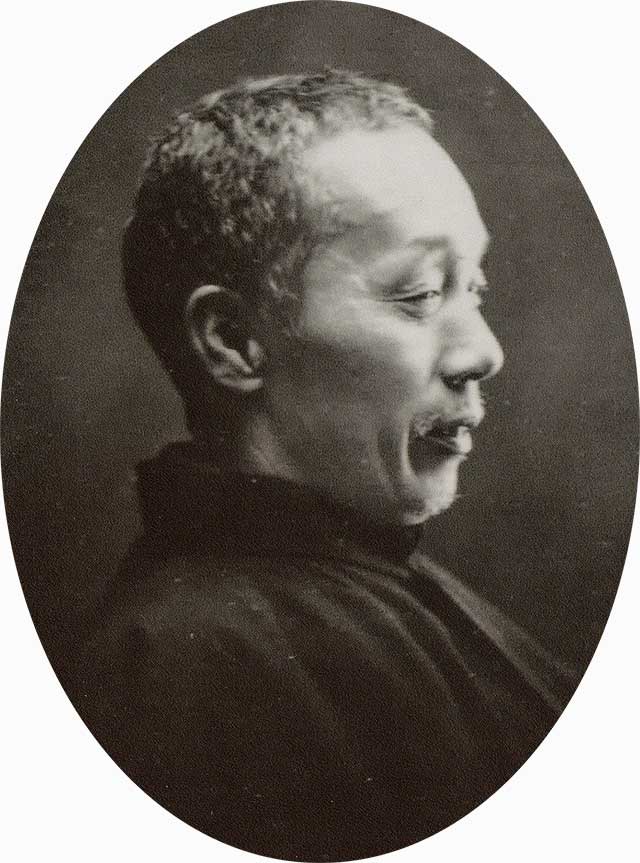
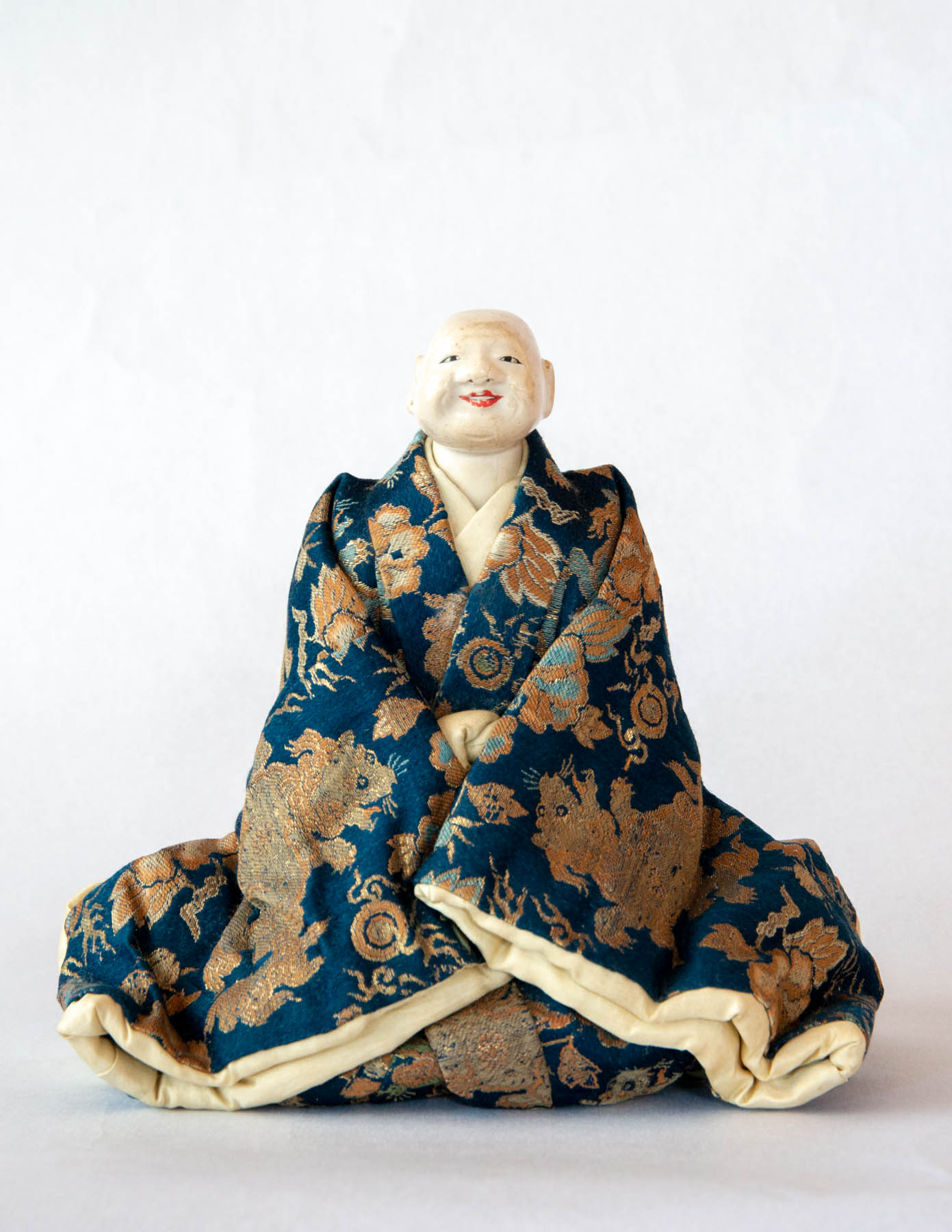
荒川亀斎が修復を頼まれ、小泉八雲に見せた「気楽坊人形」(当時は山陰新聞社主・勝部修氏蔵)。八雲は作品「英語教師の日記から」(『知られぬ日本の面影』所収)にて紹介している。
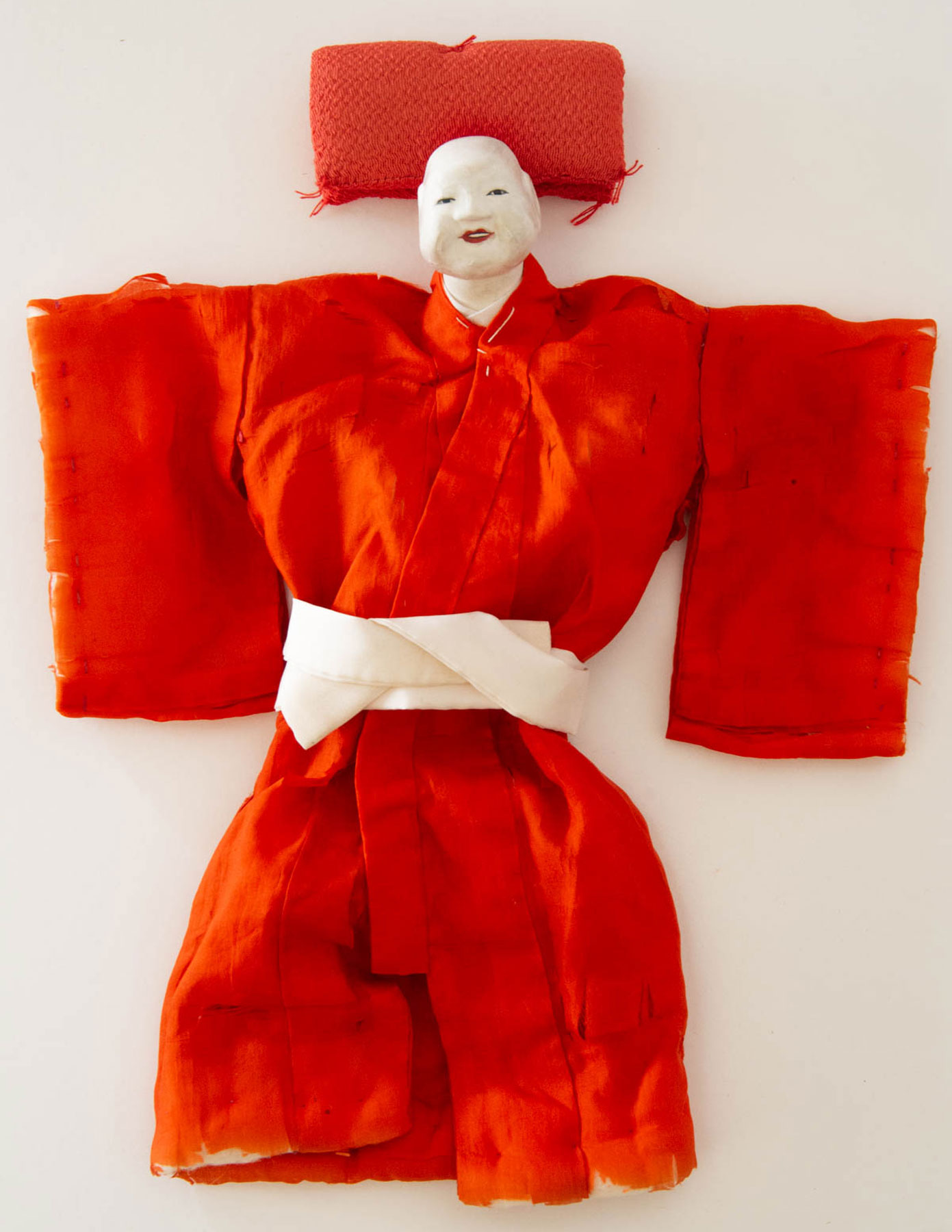
「気楽坊人形(荒川亀斎修復)」の亀斎による模作で、八雲に贈呈した人形。八雲はこれを気に入り、いつも傍らに置いていた。
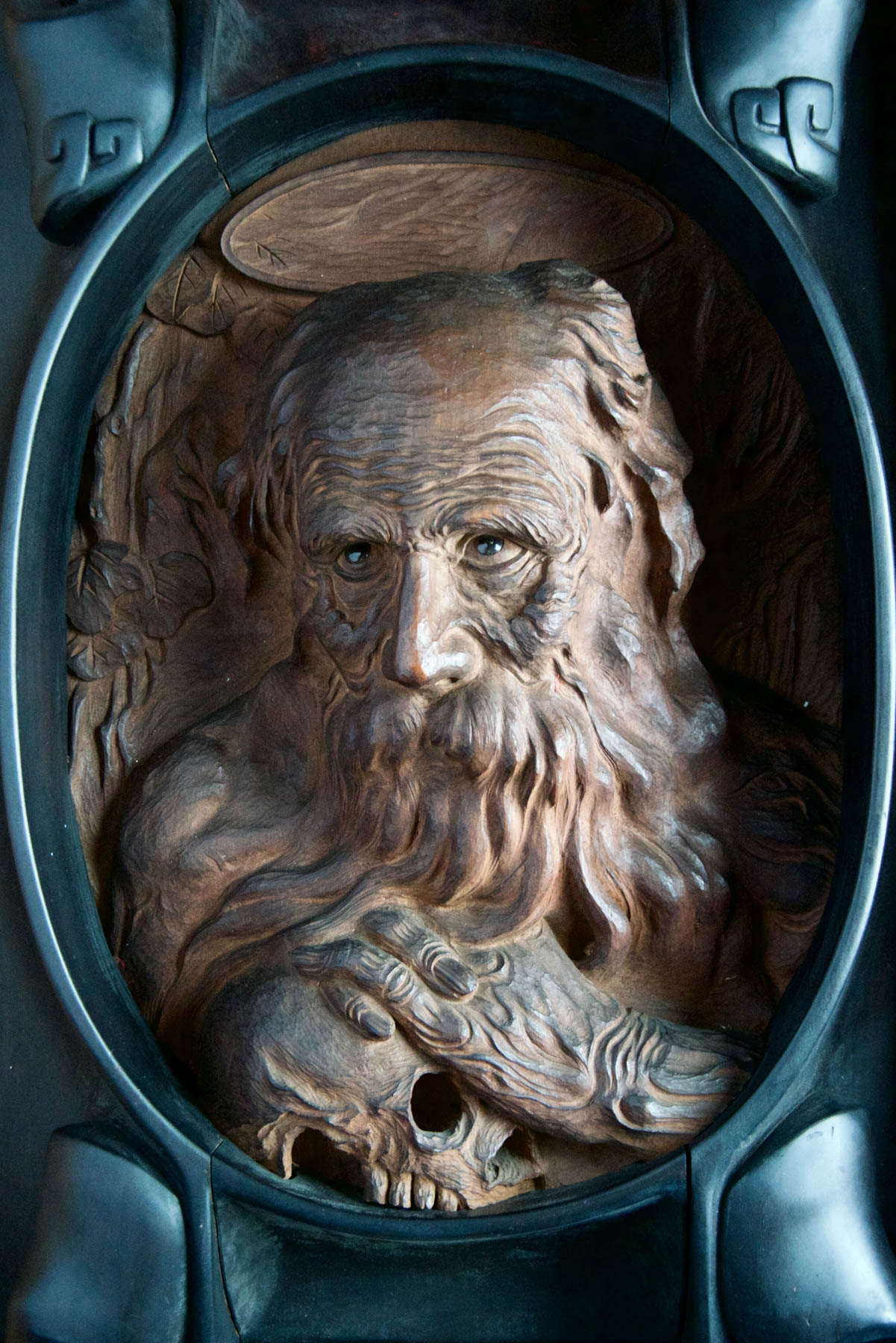
西田千太郎の主治医で、八雲もかかった田野医院の所蔵するヒポクラテス像を見に行った。
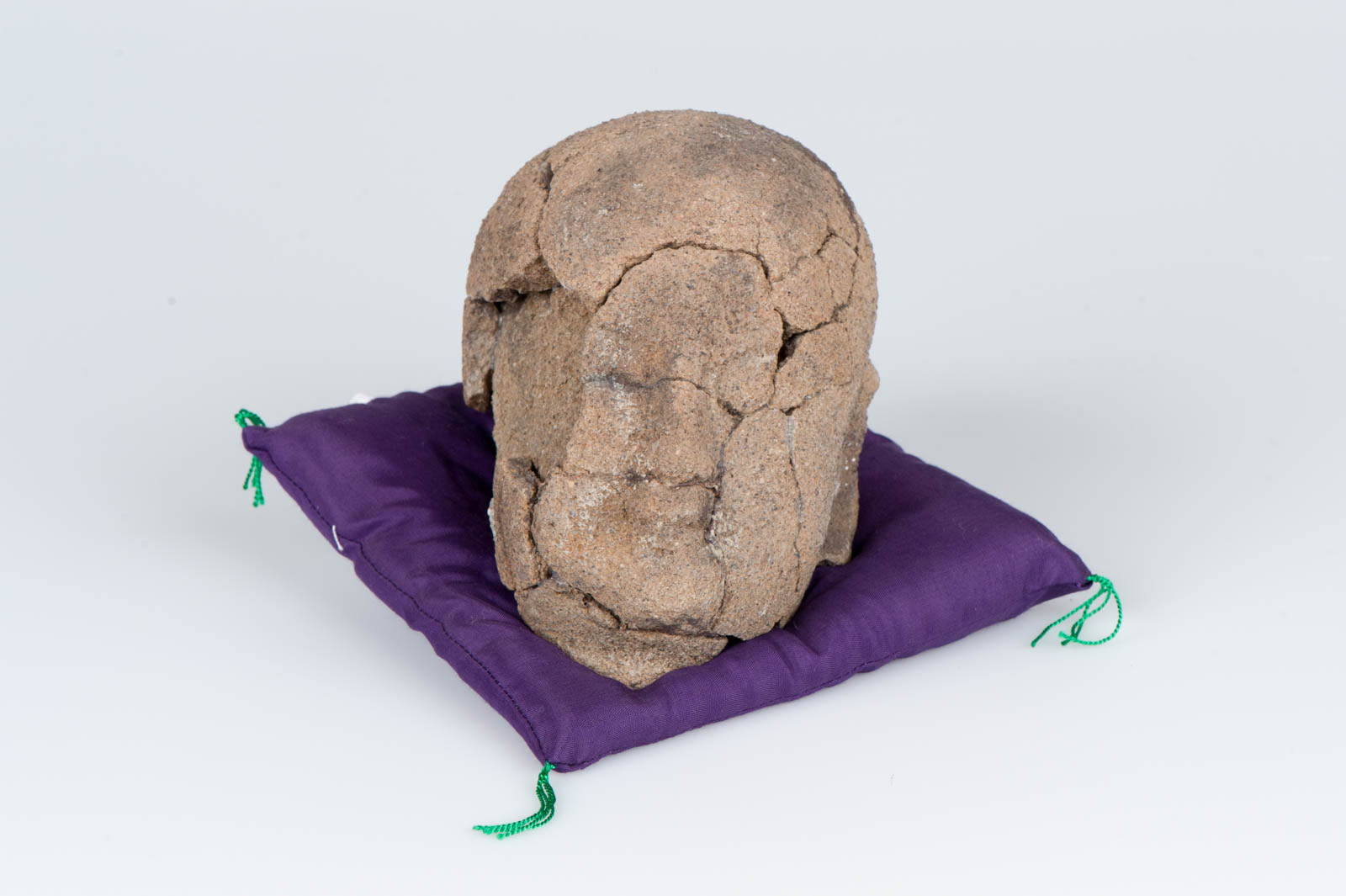
龍昌寺(松江市寺町)にあった長岡家の石地蔵を見つけ、とりわけ愛情を注いだ。亀斎と八雲の出会いは、この石地蔵による。
